Thirty years ago this summer, I went off to Europe for the first time. My homestay with a Belgian family was meant to help me speak French better – conjugating French verbs in high school had not done much to make the language a real communication tool. But while this family spoke multiple languages, including French, Flemish was in fact their daily mode of communication. Hence they waited for me to initiate French conversation…and waited…and waited.
Seriously, my teenage self did learn to speak some French that summer. More memorable, however, was the introduction to Europe. The sights, sounds, smells, tastes, and ways of life were deliciously intriguing, albeit new and strange. The family resided in Antwerp, a wonderful medieval city on the Scheldt River. I remember the impressive cathedrals, the picturesque architecture of guild halls, the amazing home and art of Peter Paul Rubens, the curious combo of French fries and mayonnaise, the stunning Belgian waffles piled high with strawberries, powdered sugar and real whipped cream – and the fact that so much was older than old.
After touring around Belgium – Brugges with its charming canals was a favorite, the older daughter took me on a whirlwind visit of London followed by several days in Paris. I said hello – bonjour – to the Mona Lisa for the first time, took a ride on the Bâteaux Mouches, wondered why the Orsay train station wasn’t in livable condition, zipped up the stairs to the top of the Tour Eiffel, found out French dressing was actually vinaigrette, and frankly, was overwhelmed by all the people speaking real français. Then we met up with the rest of the family and drove down to Spain – all the way with no AC! – for a relaxing couple of weeks at their vacation home near Valencia. I didn’t learn Spanish there but I did try the best paella on the planet.
This summer, I find myself living in northern Europe again while my husband works in Germany. It’s made me a bit nostalgic for that first visit all those years ago – maybe it’s the northern light and architecture. Although quite a lot has changed in Europe since then – big wind farms are now a fact of life – there is still so much that makes it a fascinating place. I’ve put together some musings on various cultural topics below – you could also call this a travel guide of sorts…with a decidedly French slant!
Smoking – Everyone in Europe smoked then. And despite recent laws banning smoking inside public places, it seems like most Europeans still smoke. It is a bit startling since you can go for long periods in the U.S. and never see or smell a cigarette. In France, I watch French people get up between dinner courses in restaurants to go outside for a puff; then they return to their table to finish their meal. And when you walk down the sidewalk in Paris, you have to avoid both doggie droppings – this has always been the case – and now clouds of cigarette smoke as well. Here in Germany, there are cigarette machines by bus stops – I kid you not. Maybe the theory is that when you get bored waiting for the bus, you can always light up?!
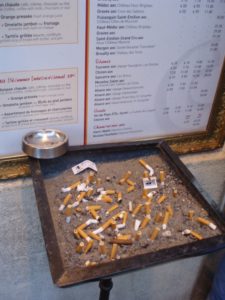
An ashtray outside a Parisian restaurant
Beverages – Beer and wine are as great as ever in Europe. And generally inexpensive. You can find nice bottles of everyday wine – white, red or rosé – at the supermarket for just a few euros. I love Provence rosés in summer and stock up on great ones for less than five euros a bottle. On the other hand, Coke and other soft drinks are expensive, often costing more than wine. And when you go to a French cocktail party or art opening or have aperitifs before dinner at someone’s home, the beverage choices will usually be wine, mineral water and fruit juices, no cokes in sight.
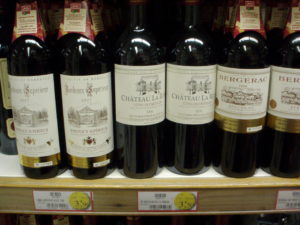
Drinkable Bordeaux reds for next to nothing at a Paris supermarket
Electricity – Electric power continues to be exorbitantly expensive in Europe. I read a recent report that electricity in Germany costs 2.5 times what it does in the U.S. To economize, many hotels in Europe put their room and hallway lights on timers so you have to reset them to keep the lights on. Parisian apartment buildings do this with their hallway and stairwell lighting. And I remember that my Parisian friend Anne always kept her apartment dim during day preferring, she said, natural light. Looking back on it, I think she kept the lights off to keep her electric bill manageable.
Natural Light – Speaking of light, the differences in natural light between the U.S. and Europe can always be a bit unnerving. European summers mean long light days since it is so far north. Here in Germany at the moment, it gets light – and the birds start singing! – at 4am. And it doesn’t get dark until about 10:30pm. You need good light-blocking curtains to get a decent night’s sleep. Similarly in winter, Paris gets dark about 4:30pm and stays that way until about 8:30am the next day. Getting up early for work or school December through February can be a challenge when the sun rises assez tard (rather late).
Money – Perhaps the biggest difference between Europe back then and Europe now is the European Union and the use of the euro. I remember traveling around during my France semester abroad and carrying about seven or eight different currencies at one time – French francs, Italian lira, German marks, Austrian schillings, Swiss francs, Spanish pesetas, and so on. Of course it was kind of a pain, but it also made each country unique and somehow special. Now with the euro – and the ubiquitous use of credit cards – traveling is much simpler. But the euro has made things cost more in Europe – and who knows where the current euro-zone economic crisis will end up?
Phones – Traveling around these days in Europe is also wildly easier with mobile phones and the internet. Lost and can’t find your hotel? You can either call to have them guide you there or google directions on your phone. Way back when, you’d have to rely on your guidebook or the kindness of strangers to help you find your destination.
Public Transport – Public transport in Europe continues to be the envy of the world. Train, bus and subway systems with superb coverage and extensive schedules make getting around a breeze. Except of course if the French transport unions decide to strike while you are visiting France. Then it’s back to walking – or a taxi if you can get one. Or many French cities and towns now have a free bike system enabling residents and visitors alike to get around on two wheels. Just keep an eye out for traffic and pedestrians!
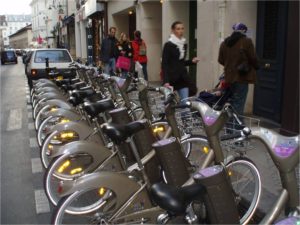
A Velib’, or ‘free bike’, stand in Paris
Walking – Walking is still the best way to get around and take in great sights, engage in people watching and discover things unique and original about where you are. But long jaunts on cobblestones can also mean blisters and sore feet. To answer this need, Europeans have long specialized in good foot care. Check out the foot section at the local pharmacy or pharmacy section of the supermarket to see the incredible array of products. In Paris, I buzz by Monoprix (the French equivalent of Target) to pick up some small bandages or anti-blister adhesive – one of my favorite French products! – to help get back to good walking form.
Food – Great cuisine continues to be a major attraction in Europe. Special regional cooking, extraordinary culinary artistry and fresh products make eating a fantastic pleasure here – I just ignore the influx of fast food joints (mainly American). France continues to lead in great food department though other countries like Spain and Denmark are hot foodie destinations. In France, I love open air food markets for the colorful fruits and vegetables that are so fresh and flavorful you wonder if they are fake. Just kidding. Lately, I’ve been enjoying the incredibly fresh produce in Germany – strawberries, rhubarb and white asparagus are the stars at the moment. Here is the fresh strawberry stand outside the nearby supermarket. A whole kilo (2.2 pounds) of juicy, sweet strawberries is 4,40 euros, or less than $6!
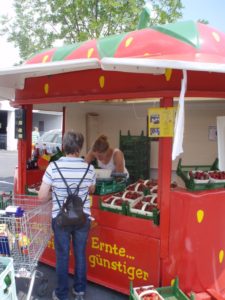
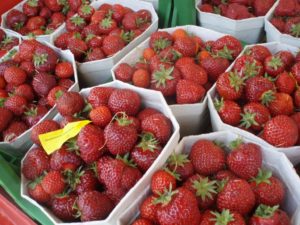
Café Life – Since first coming to Europe, I have found the café culture to be a rich part of life here. Cafés are a way of being in Europe – and they are also a way of extending the living space of typically small apartments and houses. In France, stopping at local café in the morning for a coffee, in the afternoon for fresh lemonade (un citron pressé) or beer or a glass of wine, or in the evening as a wind-down after work or dinner is as normal as breathing. Nowadays, I find the numerous Starbucks outlets in Paris jarring – but to be fair, I think they have added a ‘café aspect’ to American life that was sorely lacking.
Church Bells – In this era of high-tech everything, you might expect the sound of real church bells to become obsolete. Not so in Europe. Church bells ring with regularity – often every quarter hour – in towns and cities everywhere. Although the act of ringing is generally mechanized now, I find there is a tactile, endearing quality to this daily experience. I think bells hark back to a time of active community life – church bells were an important communication system – and also served as earthly reminders of a heavenly presence. The bells themselves were musical works of art as well. Today, you just don’t want to be staying in a village somewhere where the church bells ring through the night. Thankfully, I find most European towns and cities keep bell ringing to the daytime hours.

I love the bells of Sainte Clothilde in Paris
On that note – no pun intended – I’ll wrap up this informal European travelogue even though there are many more cultural topics that come to mind. In this era of the European Union, globalization and the internet, it seems the history and beauty of Europe are still there though perhaps more watered down than in the past. But I am hopeful that the various European languages and social customs handed down through the centuries will keep each country a special and unique place unto its own. Vive la différence!